A great harmoniser
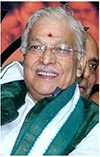 The human heart in him got Atalji instantly connected with people. He
translated this quality in ensuring cultural, civilizational, spiritual,
infrastructural connectivity. Atalji connected people, villages, towns,
countries and even diverse political ideologies to stitch a diverse
coalition of parties unparalleled in history ushering in a new paradigm
in politics, states Dr Murli Manohar Joshi
The human heart in him got Atalji instantly connected with people. He
translated this quality in ensuring cultural, civilizational, spiritual,
infrastructural connectivity. Atalji connected people, villages, towns,
countries and even diverse political ideologies to stitch a diverse
coalition of parties unparalleled in history ushering in a new paradigm
in politics, states Dr Murli Manohar Joshi
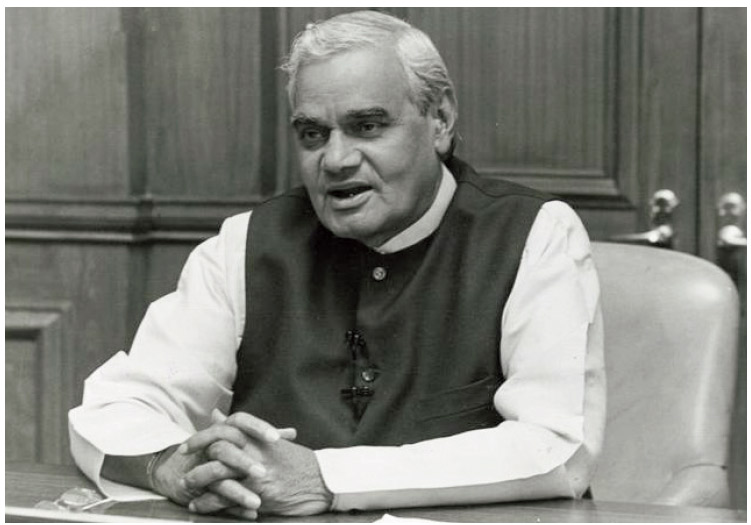
Atal the Prime Minister, Atal the Foreign
Minister, Atal the Orator, Atal the Politician
but along with all there epithets, I also know
Atal the human being, Atal the harmonizer
and Atal who introduced a new paradigm of
political conduct based on Humanity
(Insaniyat) and Reconciliation both in the national and
international arena. He believed in connecting people
locally as well as globally.
The human heart in him got him instantly connected
with people, and he translated this quality in ensuring
cultural, civilizational, spiritual, infrastructural
connectivity. Atalji connected people, villages, towns,
countries and even diverse political ideologies to stitch a
diverse coalition of parties unparalleled in history
ushering in a new paradigm in politics.
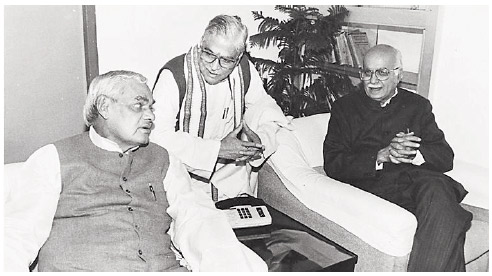 His views, expressed during the New Delhi conference
on the Dialogue Among Civilisations organized by the
dialogue based on the recognition of
diversity and harmonizing the
different viewpoints through
reconciliation. I consider Vajpayee -
the Harmoniser and Reconciliatier -
as one of the greatest leaders of
modern India.
His views, expressed during the New Delhi conference
on the Dialogue Among Civilisations organized by the
dialogue based on the recognition of
diversity and harmonizing the
different viewpoints through
reconciliation. I consider Vajpayee -
the Harmoniser and Reconciliatier -
as one of the greatest leaders of
modern India.
Connectivity was the Mantra
which Vajpayee used as a great
unifier: To connect people, he used
infrastructure as a platform to
connect the country’s four corners
in the form of Golden Quadrilateral
project; which is touted as amongst
world’s longest people highways
project running 5846 km, aimed to
connect major agricultural,
industrial and cultural centres of
India.
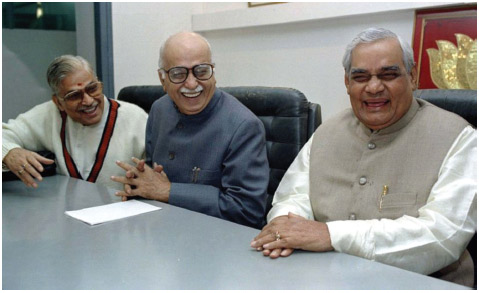 Former Prime Minister Atal Bihari Vajpayee with other BJP stalwarts
Lal Krishna Advani and Dr Murli Manohar JoshiHis views, expressed during the New Delhi conference
on the Dialogue Among Civilisations organized by the
Ministry of Human Resource
Development in 2003, were an
indication of his global concerns, his
keen desire to develop a new art
and science of dialogue among
civilizations as an indispensable
instrument for sustainable culture
of reconciliation and peace in the
world.
Former Prime Minister Atal Bihari Vajpayee with other BJP stalwarts
Lal Krishna Advani and Dr Murli Manohar JoshiHis views, expressed during the New Delhi conference
on the Dialogue Among Civilisations organized by the
Ministry of Human Resource
Development in 2003, were an
indication of his global concerns, his
keen desire to develop a new art
and science of dialogue among
civilizations as an indispensable
instrument for sustainable culture
of reconciliation and peace in the
world.
Vajpayee believed in creating a
vibrant atmosphere of concord and
amity among nations, continents,
civilizations and peoples of the
world. He wanted to create a
paradigm of conduct of
international affairs through
dialogue based on the recognition of
diversity and harmonizing the
different viewpoints through
reconciliation. I consider Vajpayee -
the Harmoniser and Reconciliatier -
as one of the greatest leaders of
modern India.
Connectivity was the Mantra
which Vajpayee used as a great
unifier: To connect people, he used
infrastructure as a platform to
connect the country’s four corners
in the form of Golden Quadrilateral
project; which is touted as amongst
world’s longest people highways
project running 5846 km, aimed to
connect major agricultural,
industrial and cultural centres of
India.
On one side, was the Golden
Quadrilateral project, and on the
other side, he gave equal
importance to the Pradhan Mantri
Gram Sadak Yojna for connecting
the rural areas, thereby leading to a
major economic boost for the
economy. He also created the
Ministry of Development of North
Eastern Region to connect this
sector with the rest of the country.
To ensure that connectivity was
not only limited to hardinfrastructure
through highways, he
laid the foundation for a ‘Connected
India’ through the national opticfiber
network; the technology
highway. This paved the way for
creating the world’s largest and
most cost-effective telecom market
in the world, thereby giving a major
boost to the IT revolution. Today, if
India has the second largest mobile
subscriber base, it is due to Atalji’s
policies that laid the roadmap for
the telecom sector.
To connect people, he
used infrastructure as a
platform to connect the
country’s four corners in
the form of Golden
Quadrilateral project;
which is touted as
amongst world’s longest
people highways
project running 5846
km, aimed to connect
major agricultural,
industrial and cultural
centres of India.
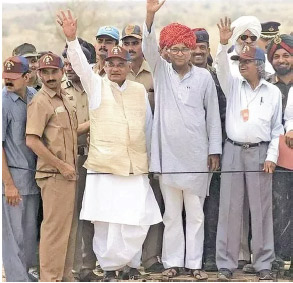 PM Vajpayee at the site of the
Pokhran blast
India has the largest diaspora in
the world at 16 million. The Pravasi
Bhartiya Divas was the brainchild
of Atal Bihar Vajpayee to connect
this Indian diaspora across the
world and to rekindle their interest
for India. This was the most
innovative programme to ‘connect’
amongst the globally scattered
Indians. This also led to these
Indians coming back or / and investing in India.
Vajpayee understood the
importance of regional diplomacy in
ensuring connectivity through the
Look East policy; a master stroke of
Vajpayee as an effort to cultivate
extensive economic and strategic
relations with the nations of
Southeast Asia in order to bolster its
standing as a regional power, and a
counterweight to the strategic
influence of China. His foreign
policy, on one side, looked at cordial
relations with the super-powers, but
also, gave equal importance to
neighbours through the Look – East
Policy, and this was also about
taking everyone along and keeping
the interest of India paramount.
PM Vajpayee at the site of the
Pokhran blast
India has the largest diaspora in
the world at 16 million. The Pravasi
Bhartiya Divas was the brainchild
of Atal Bihar Vajpayee to connect
this Indian diaspora across the
world and to rekindle their interest
for India. This was the most
innovative programme to ‘connect’
amongst the globally scattered
Indians. This also led to these
Indians coming back or / and investing in India.
Vajpayee understood the
importance of regional diplomacy in
ensuring connectivity through the
Look East policy; a master stroke of
Vajpayee as an effort to cultivate
extensive economic and strategic
relations with the nations of
Southeast Asia in order to bolster its
standing as a regional power, and a
counterweight to the strategic
influence of China. His foreign
policy, on one side, looked at cordial
relations with the super-powers, but
also, gave equal importance to
neighbours through the Look – East
Policy, and this was also about
taking everyone along and keeping
the interest of India paramount.
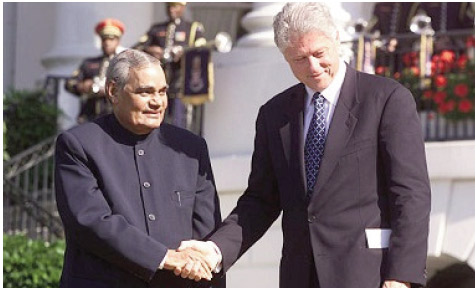 Vajpayee with US President Bill Clinton
When it came to ensuring a
stronger India, he not only took a
decisive step to do the Pokharan
but also, stood his ground and
raised the stature of India as a
nuclear power, something that
remained elusive for seven
decades. After the Pokharan blast
India was threatened by severe
global sanctions. With great
maturity and skill he steered
clear of the situation, signed a
vision document with the USA
and a Declaration with Russia.
Vajpayee also engaged with China
to establish a mechanism like SR
for peaceful resolution of the
border dispute. He was firm in
rejecting the US request to send
the Indian Army to Iraq.
Vajpayee with US President Bill Clinton
When it came to ensuring a
stronger India, he not only took a
decisive step to do the Pokharan
but also, stood his ground and
raised the stature of India as a
nuclear power, something that
remained elusive for seven
decades. After the Pokharan blast
India was threatened by severe
global sanctions. With great
maturity and skill he steered
clear of the situation, signed a
vision document with the USA
and a Declaration with Russia.
Vajpayee also engaged with China
to establish a mechanism like SR
for peaceful resolution of the
border dispute. He was firm in
rejecting the US request to send
the Indian Army to Iraq.
In implementing antyodaya,
he gave farmers a high priority.
Farmers’ welfare was close to his
heart, and he ensured that credit
card was not a rich man’s status
symbol but a poor farmer’s basic
necessity; kisans also got Kisan
Credit cards. Such was the kind of
out-of-box thinking Vajpayee
brought to the public welfare and
governance.
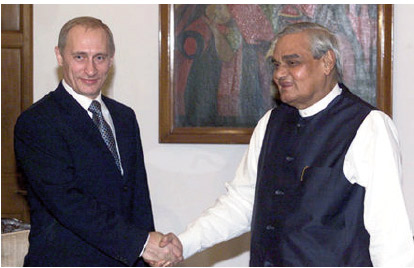 Vajpayee with Russia's President Vladimir Putin
Atalji realised the importance of
education and technology for
development and made education a
fundamental right through the
Sarva Shiksha Abhiyan, and
connected people via education,
and this was the biggest educational
programme for the universalization
of elementary education. It was
during his time as the Prime
Minister when for first time Indian
Institute of Information Technology
was opened in different places and
seeds were sown to create a
knowledge society. He strengthened
Lal Bahadur Shastri's slogan 'Jai
Jawan-Jai Kisan' by enhancing to
'Jai-Jawan-Jai Kisan-Jai Vijnan'.
Atal’s era fast-forwarded India’s
development through his policies
and programmes. As a result, India’s
GDP consistently grew at eight per
cent, which was for the first time in
the history of the country, inflation
was controlled and foreign
Vajpayee with Russia's President Vladimir Putin
Atalji realised the importance of
education and technology for
development and made education a
fundamental right through the
Sarva Shiksha Abhiyan, and
connected people via education,
and this was the biggest educational
programme for the universalization
of elementary education. It was
during his time as the Prime
Minister when for first time Indian
Institute of Information Technology
was opened in different places and
seeds were sown to create a
knowledge society. He strengthened
Lal Bahadur Shastri's slogan 'Jai
Jawan-Jai Kisan' by enhancing to
'Jai-Jawan-Jai Kisan-Jai Vijnan'.
Atal’s era fast-forwarded India’s
development through his policies
and programmes. As a result, India’s
GDP consistently grew at eight per
cent, which was for the first time in
the history of the country, inflation
was controlled and foreign
The Atal era marked an allencompassing
approach
where there could be
differences in opinion, but
at the end, there was a
consensus in approach. He
decisively steered the
country out of a statusquo
that had besieged the
nation for decades. Not
only he stitched a coalition
of diverse ideologies but
also carried through major
reforms managing a
diverse coalition.
exchange reserves kept growing and
this was in the times of global
uncertainties, and certainly not a
small feat during the period of Asian
crisis.
The Atal era marked an allencompassing
approach where
there could be differences in
opinion, but at the end, there was a
consensus in approach, and he
decisively steered the country out of
a status-quo that had besieged the
nation for decades. Not only he
stitched a coalition of diverse
ideologies but also, carried through
major reforms managing a diverse
coalition.
Atal Bihari Vajpayee was a
man on a mission, who, through
his vision, words and actions,
became a great consensus builder;
father of coalition form of
government, conciliatory politics; and inclusive development.
Atalji has shown the world a new
paradigm of politics ‘The Atal
Paradigm’. Atalji will remain
immortal. His contributions have
shaped the future of New India. My
association with Atalji cannot be
described in a single media column.
For such a multi-faceted personality
- a tall statesman, it is best defined
by his vision, thoughts, his style of
politics and, in fact, all which gave a
lead towards a glorious era.
[Dr. Murli Manohar Joshi,
former President of the BJP,
had been a close colleague
of Prime Minister Atal
Bihari Vajpayee and served
him as a senior Cabinet
colleague]







 Former Prime Minister Atal Bihari Vajpayee with other BJP stalwarts
Lal Krishna Advani and Dr Murli Manohar Joshi
Former Prime Minister Atal Bihari Vajpayee with other BJP stalwarts
Lal Krishna Advani and Dr Murli Manohar Joshi PM Vajpayee at the site of the
Pokhran blast
PM Vajpayee at the site of the
Pokhran blast Vajpayee with US President Bill Clinton
Vajpayee with US President Bill Clinton Vajpayee with Russia's President Vladimir Putin
Vajpayee with Russia's President Vladimir Putin